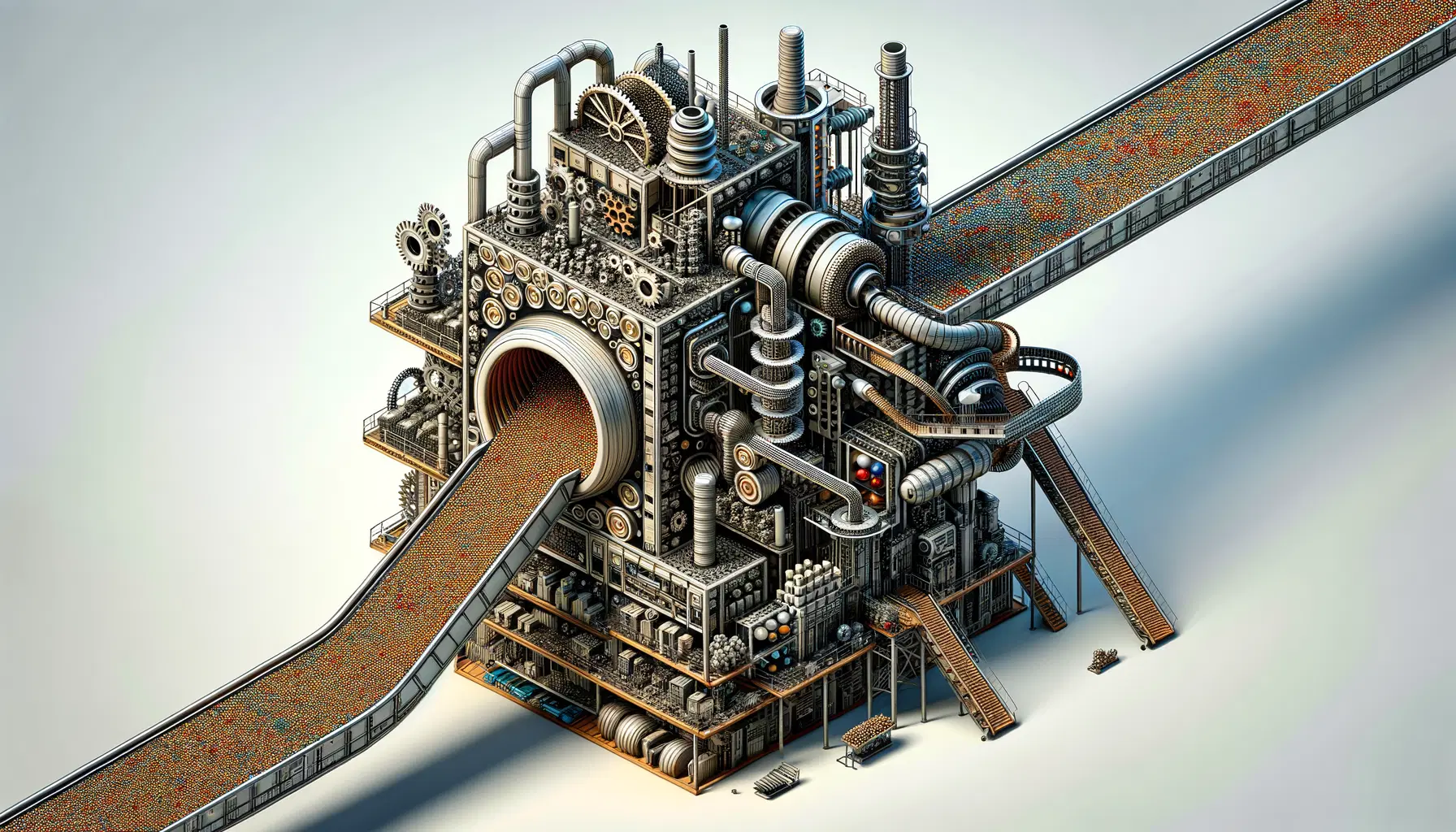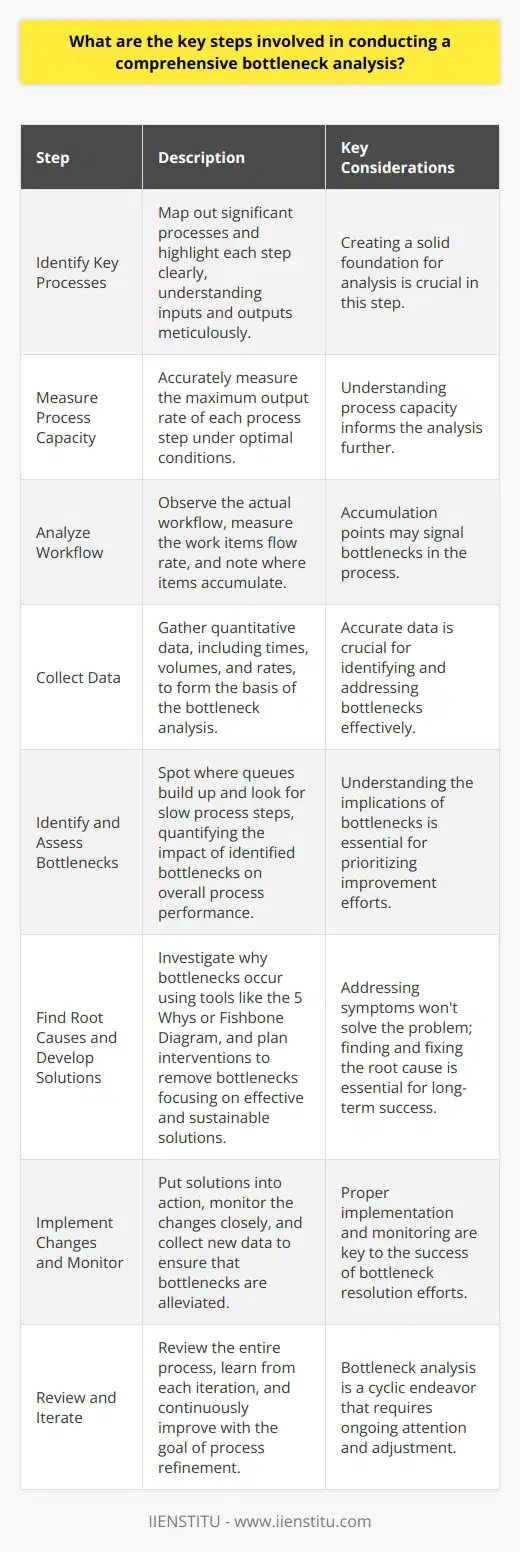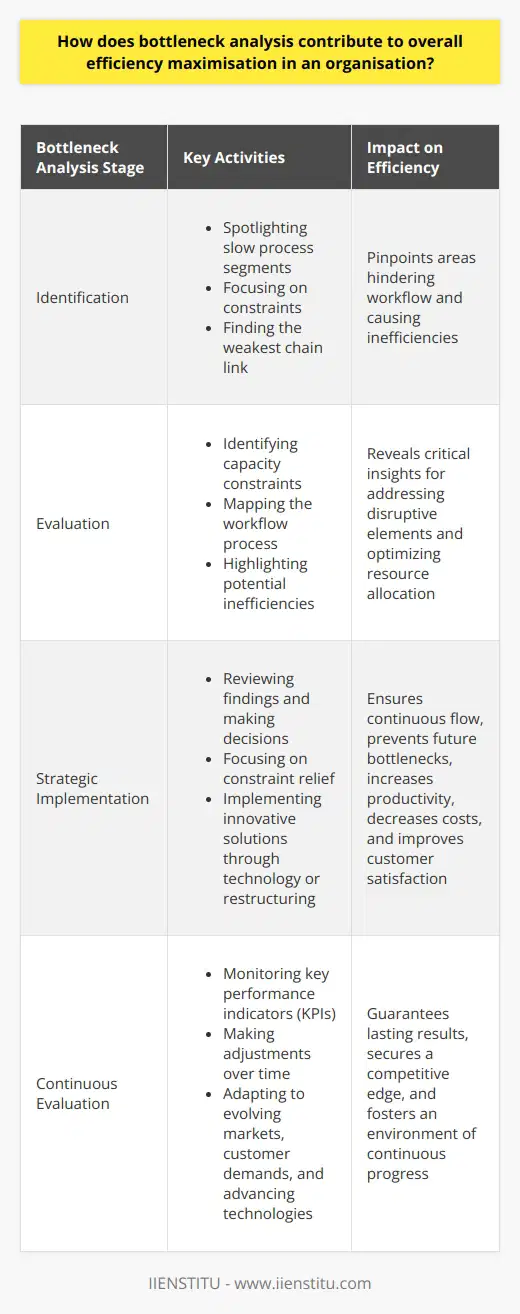
In a rapidly evolving business landscape, efficiency is the cornerstone of sustainable success. Bottleneck analysis emerges as a pivotal methodology to unclog the pathways of production and service delivery, ensuring that organizations operate at their optimal capacity. Bottleneck analysis refers to the process of identifying the point where the flow of operations is limited or restricted, much like the narrow neck of a bottle slowing down the flow of liquid.
This comprehensive guide will delve deeply into the multifaceted world of bottleneck analysis, ensuring that by completion, readers will have a grasp not only on the theory and importance of this technique but also on practical strategies and real-world applications that exemplify its transformative potential.
Defining Bottleneck Analysis
Bottleneck analysis is an integral part of process improvement, utilized by business analysts and management professionals to pinpoint areas where processes slow down or become less effective. By identifying these obstacles, organizations can devise targeted strategies to alleviate or eliminate such constraints, thereby enhancing overall performance and productivity.
The Relevance and Importance of Bottleneck Analysis in Business
In today’s highly competitive environment, companies are constantly seeking ways to streamline operations and maximize output. Occupying a central role in this quest for enhanced productivity, bottleneck analysis emerges as a tool of undeniable significance for businesses keen on maintaining agility and staying ahead of the curve.
Brief Overview of Blog Content
As we dissect the anatomy of bottleneck analysis, we will explore its historical background, examine how bottlenecks can impact businesses, and highlight various strategies for identifying, diagnosing, and overcoming these inefficiencies. Rich with real-world examples and case studies, this blog post is designed to enrich the reader's understanding of a topic pertinent to a myriad of industries.
Understanding Bottleneck Analysis
The effectiveness of an organization's workflow can be significantly undercut by bottlenecks, which act as critical chokepoints that stifle efficiency and impede progress. A profound understanding of bottleneck analysis is the first step to optimizing operations within any business structure.
Detailed Explanation of Bottleneck: The concept of a bottleneck is drawn from a vivid analogy; just as the narrow top of a bottle restricts the flow of a liquid, similarly, in an operational context, a bottleneck refers to a stage in the production or service process which limits throughput due to its limited capacity compared to preceding or subsequent stages.
How Bottlenecks can Impact Businesses: Bottlenecks can have a far-reaching influence on business performance, leading to increased lead times, inventory pile-ups, wasted resources, and ultimately, reduced customer satisfaction. When throughput is hampered, the business suffers not just in terms of operational efficiency but also financially and in market competitiveness.
Key terminologies and Concepts Related to Bottleneck Analysis: Mastering bottleneck analysis necessitates familiarity with terms such as "throughput", "work in progress (WIP)", and "cycle time". These terminologies lay the groundwork for a nuanced comprehension of this method, facilitating a proficient articulation of solutions to identified bottlenecks.
The Concept of "Bottleneck"
The origin and application of the term "bottleneck" offer fascinating insights into operational management. Its significance in business parlance reveals the universal quest for peak efficiency across all sectors.
The History of the Term "Bottleneck": Tracing back to the early days of industrialization, the term was adopted to describe hindrances within a manufacturing process. Over time, as service industries burgeoned, the idea of bottlenecks became equally relevant in non-manufacturing contexts, signifying any obstruction that could slow down or stymie workflow.
The Relationship between Bottleneck and Efficiency in a Business Context: Efficiency and bottlenecks are inversely related; the presence of a bottleneck is indicative of inefficiency. However, identifying and resolving a bottleneck can significantly boost efficiency, yielding enormous benefits in cost savings, lead time reduction, and quality improvement.
Elements Creating Bottlenecks in an Organization's Workflow: Several factors can contribute to creating bottlenecks, including inadequate resource allocation, machine breakdowns, flawed process design, or lack of staff training. It is imperative to scrutinize the workflow comprehensively to identify these impediments promptly.
Identifying and Diagnosing Bottlenecks
The detection and diagnosis of bottlenecks are critical stages in bottleneck analysis. The use of various tools and techniques can refine this process, allowing for timely and accurate identification.
Indicators of a bottleneck: Common signs of a bottleneck include long wait times, high levels of inventory before or after a specific stage, and staff overburden at certain points. Recognition of these symptoms is the prelude to diagnosis.
Bottleneck Management: Tools and Techniques for Identifying Bottlenecks
Several analytical tools such as Gantt charts, workflow diagrams, and simulation models are prominent in the identification of bottlenecks. Applying these tools ensures a methodical and data-driven approach to bottleneck management.
Real-world Examples of Bottlenecks in Various Industries
Consider the congestion on an assembly line in manufacturing or the repetitive backlogs in customer service queues. These scenarios underscore the universal applicability of bottleneck analysis, further emphasizing the importance of this process across sectors.
Approaches to Bottleneck Analysis
To execute bottleneck analysis effectively, varying methodologies are employed, each with its advantages and disadvantages. The approach selected may depend on the complexity of the process in question, the resources available, and the underlying industry.
The Process Approach, including Process Categories and Flowcharting: Under the process approach, workflow is decomposed into distinct categories, graphically represented through flowcharting. This visualization assists in pinpointing stages where bottlenecks are most likely to occur.
The Value Stream Mapping Approach: Value stream mapping (VSM) is another potent tool for bottleneck analysis, which illuminates the flow of materials and information as a product makes its way through the value chain. VSM can reveal both current and future state maps, enabling a proactive approach to bottleneck management.
Advantages and Disadvantages of Different Approaches: No single approach is foolproof. For instance, the process approach is straightforward but may not capture the complexities of cross-departmental bottlenecks, while VSM provides a more comprehensive outlook but requires deeper analysis and cross-functional collaboration.
Strategies to Overcome Bottlenecks
Alleviating the effects of bottlenecks and preventing their occurrence is a multifaceted undertaking. Techniques for enhancing efficiency, best management practices, and the incorporation of technology are paramount in this endeavor.
Techniques to Enhance Efficiency: Some strategies for overcoming bottlenecks include increasing capacity at the bottleneck, cross-training employees to ensure flexible resource allocation, and adopting lean methodologies such as just-in-time production to streamline operations.
Management practices to Avoid or Minimize Bottlenecks: Proactive management practices, such as predictive maintenance to prevent equipment failure and the implementation of a problem solving course free of charge for all employees, can significantly minimize the frequency and impact of bottlenecks.
The Role of Technological Innovation in Addressing Bottlenecks: Advancements in technology, including automation and artificial intelligence, play a crucial role in identifying and resolving bottlenecks. These innovations facilitate real-time monitoring and predictive analytics, which are game-changers in the field of process optimization.
Case Studies of Successful Bottleneck Analysis
Case studies serve as invaluable resources for understanding the application of bottleneck analysis in a practical context. They reveal the diversity of problems and the ingenuity of solutions across industries.
Case Study 1- Effective Bottleneck Analysis in the Manufacturing Industry
In the manufacturing industry, a case study might detail how a company implemented changes in the layout of the production floor to alleviate a persistent bottleneck in the packaging line, resulting in a substantial improvement in throughput.
Case Study 2 - Addressing Bottlenecks in the Service Industry
In the service industry, another case might narrate the journey of a call center that utilized bottleneck analysis to streamline its customer response system, enhancing both the efficiency and quality of its client interactions.
Analysing the Success and Strategies Implemented in Each Case Study
Through the lens of each case study, the critical role of leadership commitment, employee involvement, and continuous assessment in the successful application of bottleneck analysis is underscored, illuminating a road map to efficiency maximization.
Conclusion
The exploration of bottleneck analysis in this guide reveals how fundamentally critical this process is for organizations to remain competitively viable and operationally strong. By dissecting the concept, identifying and resolving bottlenecks, and implementing strategic solutions, businesses can yield substantive improvements in their efficiency profiles.
Summarize key learning points about Bottleneck Analysis
From understanding and identifying bottlenecks to employing diverse approaches and techniques, the journey towards efficiency maximization is comprehensive but undoubtedly rewarding. Advocacy for solutions, such as an online certificate course, can further empower employees to identify and resolve bottlenecks.
The Future of Bottleneck Analysis - Anticipated Developments and Potential Enhancements
As we look ahead, bottleneck analysis is poised for further sophistication with the integration of advanced data analytics and machine learning, offering the promise of even more nuanced insights and proactive interventions.
Encourage Dialogue - Asking Readers for their thoughts, experiences, and strategies dealing with bottlenecks
The quest to refine the bottleneck analysis process is ongoing, and it thrives on the active participation and knowledge sharing within the business community. Readers are encouraged to contribute their insights, recount their experiences, and share strategies that have proven effective in their fight against operational bottlenecks.
Frequently Asked Questions
What are the key steps involved in conducting a comprehensive bottleneck analysis?
Understanding Bottleneck Analysis
Bottleneck analysis is a fundamental approach. It helps identify performance impediments in processes. Effective use of bottleneck analysis optimizes efficiency and productivity. It follows systematic steps for accurate identification and resolution.
Identify Key Processes
Start by mapping out significant processes. Highlight each step clearly. Understand inputs and outputs meticulously. This creates a solid foundation for analysis.
Measure Process Capacity
Each process step has a capacity. Measure it accurately. Capacity is the maximum output rate under optimal conditions. Understanding this informs the analysis further.
Analyze Workflow
Observe the actual workflow. Measure the work items' flow rate. Note where items accumulate. Accumulation points may signal bottlenecks.
Collect Data
Gather quantitative data. Measure times, volumes, and rates. Accurate data is crucial. It forms the basis of the bottleneck analysis.
Identify the Bottlenecks
Spot where queues build up. Look for slow process steps. These are potential bottlenecks. They hinder the flow and reduce efficiency.
Assess Bottleneck Impact
Quantify the impact of identified bottlenecks. How do they affect throughput? Understand their implications on overall process performance.
Find Root Causes
Investigate why bottlenecks occur. Use tools like the 5 Whys or Fishbone Diagram. This unveils underlying issues. Addressing symptoms won't solve the problem. Fix the root cause.
Develop Solutions
Plan interventions to remove bottlenecks. Focus on effective and sustainable solutions. Temporary fixes might not suffice. Think long-term.
Implement Changes
Put your solutions into action. Monitor the changes closely. Ensure that they alleviate the identified bottlenecks. Proper implementation is key to success.
Monitor and Adjust
Keep an eye on the modified process. Collect new data. Are bottlenecks shifting? Sometimes, solving one issue creates another. Be ready to adjust your solutions.
Review and Iterate
Finally, review the entire process. Learn from each iteration. Continuous improvement is the ultimate goal. Each iteration should bring process refinement.
In conclusion, bottleneck analysis is a cyclic endeavor. It includes identifying, analyzing, and resolving process blockages. Understanding each step empowers organizations to enhance their operational workflows.

How does bottleneck analysis contribute to overall efficiency maximisation in an organisation?
Bottleneck Analysis and Organizational Efficiency
Organizations strive for peak efficiency. Bottleneck analysis plays a crucial role. It identifies workflow impediments. These blockages slow down production. They form bottlenecks, impeding smooth operations.
Understanding Bottleneck Analysis
Bottleneck analysis spotlights slow process segments. It focuses on constraints. The objective is clear. Remove or minimize these hindrances. This aids in achieving linear workflow. The process requires meticulous study. It encompasses various methods. Managers find the weakest chain link. This is their starting point.
Impact on Efficiency
Efficiency maximization remains the ultimate goal. Bottlenecks hinder this achievement. They cause wait times and waste. Efficiency suffers as a result. Analyzing these bottlenecks reveals critical insights. Leaders can address these disruptive elements.
- Identify capacity constraints
- Map the workflow process
- Highlight potential inefficiencies
- Allocate resources more effectively
- Implement strategic improvements
Organizations benefit greatly from this proactive approach. It aligns resources with demands. Departments work seamlessly together. This results in an optimized workflow.
Strategic Implementation for Improvement
After analysis, action follows. Implementation proves this analysis valuable. It involves multiple steps. Teams review the findings. Decisions focus on constraint relief. Solutions often require innovation. This can be through technology or restructuring.
Enhance process design
Redistribute workloads
Upgrade machinery or software
Redefine job roles
Invest in employee training
These actions ensure continuous flow. They prevent future bottleneck formation. Workers undertake tasks efficiently. Consequently, productivity soars. Costs decrease. Customer satisfaction typically rises. The organization moves closer to its efficiency goals.
Continuous Evaluation for Sustained Efficiency
Bottleneck analysis is not a one-off event. Continuous evaluation guarantees lasting results. Organizations must monitor key performance indicators (KPIs). Adjustments may be necessary over time. Markets evolve. Customer demands change. Technologies advance.
Monitor KPIs regularly
Adjust to market changes
Invest in emerging technologies
Foster a culture of continuous improvement
Embracing these practices secures a competitive edge. Efficiency becomes not merely a target. It becomes an integral part of the organizational ethos.
In conclusion, bottleneck analysis serves as an indispensable tool. It untangles complex production lines. The clarity it provides shapes strategic decision-making. It fosters an environment of continuous progress. Efficiency is not static. It's an ongoing pursuit. Bottleneck analysis is the compass that guides this journey.

In what ways can the results of bottleneck analysis be practically applied in process improvement strategies?
Identifying Process Inefficiencies
Bottleneck analysis stands essential in operational management. It seeks out points in a process where flow limits. Such points create backups. They slow down production. Efficiency drops; so does output.
Focusing Improvement Efforts
Bottleneck analysis tells us where to focus. It highlights critical sections. Improvement efforts can then concentrate on these. Resources, both time and money, target effectively.
Increasing Process Capacity
Addressing bottlenecks increases capacity. Output per unit of time grows. Processes become smoother. Delays and wait times reduce.
Enhancing Product Quality
Quality control often suffers at bottlenecks. Rushed work results in more errors. By easing bottlenecks, teams maintain quality. They work at sustainable paces. This ensures consistent product standards.
Reducing Stress and Employee Turnover
Bottlenecks cause stress. Workers face undue pressure. Addressing these issues improves morale. It makes for a happier workforce. Lower stress leads to reduced turnover.
Optimizing Resource Allocation
Bottleneck analysis advises on resource use. It uncovers where extra resources need applying. Conversely, it identifies areas of over-resourcing. Balancing resources becomes data-driven.
Shortening Delivery Times
Products move through processes faster. Customers receive orders sooner. Shorter delivery times please customers. They can lead to repeat business.
Facilitating Continuous Improvement
Bottleneck analysis is not a one-time event. It supports Kaizen, or continuous improvement. Regular analysis ensures ongoing efficiency gains. It keeps processes competitive.
Streamlining Workflow
Eliminating bottlenecks often involves workflow redesign. Processes streamline. Unnecessary steps remove. The workflow becomes more logical and coherent.
Leveraging Technology
Bottleneck analysis may prompt technological upgrades. New tech eases task completion. Processes accelerate. Innovation drives forward at the point of need.
In conclusion, bottleneck analysis offers a strategic roadmap for process enhancement. It underpins numerous improvement strategies. It allows for smart, focused, and efficient operations management.



